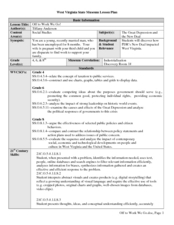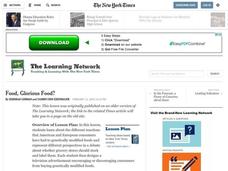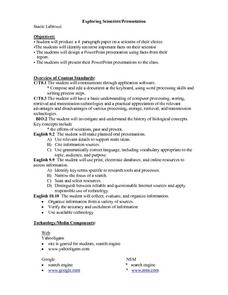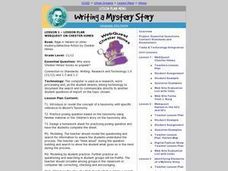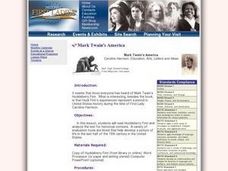Curated OER
Stone Tool Scavenger Hunt
Seventh graders use Internet to familiarize themselves with variety of stone tools used by early man, create information chart describing each tool and its purpose, and discuss why tools have survived thousands of years.
Curated OER
A Hunting We Will Go
Students navigate the Internet to research online encyclopedias and answer questions. In this navigating the net instructional activity, students answers questions and compare their answers. Students discuss information gathered and the...
Curated OER
The Watson's Go to Birmingham, 1963
Students conduct research to obtain geographical information about the author. They create brochures or fliers to highlight the author as a guest at a mock author's conference. They answer questions on the Cyber Fact Scavenger Hunt...
Curated OER
Explore the Animal World
Third graders use a variety of resources to do research on an animal. Their final project is a graphic organizer for display and an informative multimedia slide show.
Curated OER
Get the Facts
Students explore spiders. In this spider lesson, students fill out KWL charts, discover facts about spiders and how to identify different spiders. Students research spiders on the Internet and do online activities.
Curated OER
Map Skills
Students create two types of maps. In this map skills lesson, students discuss map vocabulary and view maps of Florida. Students draw a free hand map of Florida and include major cities, bodies of water and land forms. Students work...
Curated OER
A Strange Fish
Students research the sea horse. In this sea horse lesson, students use the Internet to find information about the sea horse on sites bookmarked by the teacher. The students write these facts on a page and create a sea horse poem.
Curated OER
Off to Work We Go!
Students create a book about The Great Depression in West Virginia. In this West Virginia history instructional activity, students visit the West Virginia State Museum, answer questions about West Virginia history, and create a book...
Curated OER
National and Regional Identity
Learners examine state quarters to identify symbols that represent national and regional identity. They discuss the process used to determine what is put on the quarter. They review colonial money, and euros to look for cultural images.
Curated OER
Creating Cartoons
Students produce a one slide cartoon. They import images, background, characters, and props. They research images and put it together in a Power Point presentation. They create a cartoon with sound files and apply movement through the...
Curated OER
Rainforests
Young scholars research and identify locations of the rainforest. In this rainforest lesson, students view a world map and identify the locations of the rainforest. Young scholars use a Venn diagram to compare and contrast the...
Curated OER
Everything You Ever Wanted To Know About Hot Wire Chemical Vapor Deposition, But Were Afraid To Ask
To wrap up your year of general chemistry, have lab groups compete in a tot wire chemical vapor deposition (HWCVD) competition. With their foundation in chemical nomenclature, stoichiometry, and gas laws, each group completes several...
Curated OER
Food, Glorious Food?
How are the reactions between American and European consumers different when it comes to genetically modified foods? Use the New York Times article "Consumers in Europe Resist Gene-Altered Foods" to inform your middle schoolers about the...
Curated OER
Cell Analogies!
Liken a cell and its organelles to a tiny person and its organs. After gathering information on cell structures and their functions, small groups collaborate to come up with an analogy of their own. They produce a collage describing the...
Curated OER
Planning a Trip
Students plan a trip to from 3 to 5 cities of their choice. They design a brochure to travel to the chosen cities. It should be of a quality that it could be used by a customer to decide if they would like to take this trip.
Curated OER
Here Ye! Here Ye! Read All About It!
Fourth graders explore the internet to find articles to read. In this reading comprehension lesson, 4th graders take notes on articles found on the internet. Students use the writing process to summarize the selected articles.
Curated OER
Express Yourself
Sixth graders write to Key pals. In this description instructional activity, 6th graders describe a place to their key pals and the pal has to draw a pictures based off their description. They also create a Fun Facts Worksheet about...
Curated OER
Exploring Scientists/Presentation
Students research a scientist of their choice. They write a research paper on him or her. They select ten important facts from their research paper and prepare a PowerPoint presentation using their facts.
Curated OER
WebQuest on Chester Himes
Pupils perform a WebQuest to find out why Chester Hime's detective books were so popular. Small groups perform the research together then report to the class.
Curated OER
Poetry
Twelfth graders examine the main characteristics of poetry. They read and discuss a handout on the characteristics of poetry, read the poem, The Road Not Taken, discuss their interpretation of the poem, and research poetry on the Internet.
National First Ladies' Library
Mark Twain's America
Learners read Huckleberry Finn, analyze text for historical contexts, and write book report emphasizing historical elements, type report comparing and contrasting events in book to events of today, create Powerpoint presentation...
Curated OER
Medical Research and Your Future
Students are asked to investigate current and sometimes controversial medical research in order to address what medical breakthroughs potentially exist in their futures. They create small posters on sheets detailing their support or...
Curated OER
Writing a Research Paper
Students work through the steps of writing a research paper in this lesson. They define their problem and decide what sources of information to use. They read, take notes, and organize the collected data. Finally, they write the...
Curated OER
Prey or Pray? Could YOU Escape a Cheetah?
Tenth graders estimate the size of an adult cheetah by research and measurement of a picture. They determine the approximate distance and speed of the cheetah from a filmed chase and compare that to their own running speed.









